Title : Insulin color coding tool-onset, peak duration (OPD) chart
Abstract:
The purpose of this study is to enhance insulin label awareness related to the International Insulin Color Coding System that is used on all insulin vials, pens, and packaging. With this study, an insulin color coding tool, developed and derived from the International Diabetes Federation’s color system, by a Simmons FNP student, will be implemented as an educational device for patients with DMII, to research the effectiveness of the increased identification of various color coded labels in reducing confusion and errors with multiple vials of injectable insulin. Research will likely reveal a resounding lack of awareness of this tool and raise further questions about why it is not being used widely as a safety check before administration. In theory, the insulin color coding tool will enable the patient to reach an optimal therapeutic level and maximum control over their diabetes due to increased knowledge of onset, peak, duration, and the corresponding colors. Further research will be conducted to explore the problems with color as an appropriate indicator, as DM is the leading cause of retinopathy and blindness in the country.
Audience Take Away:
• Introducing and exposing professionals and patients to a system that they may not be aware of can increase safety and reduce insulin errors when used as an educational tool.
• This system is being used in a population that is at risk for diabetic retinopathy and blindness, which raises the question as to whether color is appropriate as an indicator; symbols may need to be considered instead.
• As the population of male nurses and providers of direct patient care, the odds of color blindness increase; men have a higher prevalence of color blindness then women and the color system could actually lead to more errors if used as a solitary indicator.
• How will this help the audience in their job?
• Color coding allows for an additional safety check in the reduction of self-administered insulin in patients that take more than one insulin. The OPD chart is also a great visual tool to help patients actively learn how their prescribed insulin is working in their body.
• Is this research that other faculty could use to expand their research or teaching?
• Education is the cornerstone of safe and prudent care and the OPD chart can be given as a tool for patients to take home along with other diabetic teaching tools. It can be updated as the system changes, but the mechanism of action on the body will not change, so patients will walk away with invaluable knowledge; taking an active role in their own care by learning how insulin works in the body is empowering. Also, nurses regularly score poorly on how the different insulin’s work, so by having the OPD enlarged to a poster size, to hang in plain sight, can serve as an ever-present tool to use, refer to, and learn from.
• Does this provide a practical solution to a problem that could simplify or make a designer’s job more efficient?
• I believe that by conducting my study about the effectiveness of this tool for patient use at home, results will reveal that the system is very beneficial ifutilized; it could also strongly indicate that it is a useless system.
• Will it improve the accuracy of a design, or provide new information to assist in a design problem?
• The design problem already exists;no one knows about the color coding system. Providers, pharmacists, nurses, ARNPs, patients, families, and everyone else is absent of knowledge of this system and it either needs to be strongly promoted as a tool or completely redesigned. I hope the OPD chart will allow all facets of the healthcare team to understand the system and use it in a way that I believe it should be used.



